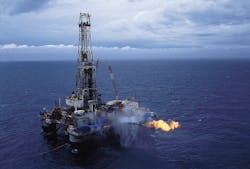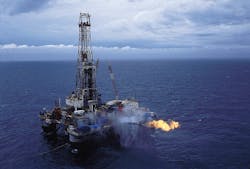Seventy US Gulf deepwater fields awaiting development; 26 in production
Marshall De Luca
Survey Editor
More non-US based operators are working in the deepwater US Gulf. Above, Elf is testing a discovery.
- US Gulf of Mexico Deepwater Fields, Prospects (Over 1,000 ft. water depth)
- Table continued
Currently, the US Gulf holds a total of 96 deepwater prospects. This is equivalent to 19 new discoveries per year, or a 17% growth rate for deepwater discoveries, at current technological capabilities, further solidifying the US Gulf of Mexico's status as a leading deepwater exploration region.
Of the 96 prospects, 26 have been developed and are onstream, with the remaining 70 under study, or in some stage of planning or fabrication. Forty of the 70 developable discoveries have been given prospect names, which shows a strong indication towards future development. Sixty-eight of the discoveries are in the planning stages. The remaining two are awaiting fabrication of the production system.
27 rigs at work
US Gulf deepwater drilling is currently at an all time high. According to Minerals Management Services (MMS), a record 27 deepwater rigs are drilling in Gulf water depths greater than 1,000 feet. With the rapid increases in deepwater technology, exploration is becoming more feasible and more economically viable for a greater number of companies, besides the major international operators. This is resulting in increased activity from two other groups of operators who were significantly involved in deepwater previously:Both groups are represented in this year's survey of deepwater prospect operators, but are partners in other leases they do not operate. One characteristic of deepwater operations has been to share the high risks and costs by bringing partners aboard as interest holders. Another aspect has been the independents' desire to find prospects, but bring major operators aboard to assist in development.
Priority depth range
Even with the new advances and greater experience in water depths over 3,000 ft, the bulk of development activity is taking place in the 1,000-1,999 ft range, where 46 prospects are listed as developable. The 1,000-1,999 ft range has shown the greatest change since January, when 33 prospects were listed.Sixteen fields are located in a water depth range of 2,000-2,999 ft, 18 more in the 3,000-3,999 ft depth range, and 15 in the 4,000+ ft ultra-deepwater range. Shell holds the top ranking in the 4,000+ depth range with six prospects, including the deepest discovery, in 7,620 ft depths. That discovery is the BAHA prospect in Alaminos Canyon 600.
Deepwater production is also beginning to show a steady increase. According to the survey, 26 of the 96 prospects are currently onstream, with at least seven planned to come onstream in the next year. This is an increase of eight since January's listing. This includes three world water depth production records from Shell's Mensa and Ram Powell prospects.
Mensa has set two world records for water depth production ( 5,327 ft.) and for tieback distance to a platform (68 miles). Ram Powell set a world water depth record for a production system installation, in 3,214 feet of water. Shell and Brazil's national oil company, Petrobras, although not competing actively for records, are very close in attaining new depth records for production systems, subsea installations, and tieback distances.
Survey breakout
Forty-nine of the fields either have a development system in place (26 producing) or are planning a particular development system (23 planned). The remaining 47 prospects are under study.Of the 26 fields now in production, 12 are utilizing subsea production systems, six have installed fixed platforms, three are using tension leg platforms, two are producing with a floating production system, one is using a spar floater, one is producing from a compliant tower, and one field is using both subsea and tension leg platform production systems.
The majority (12) of the 23 fields with development systems planned will be using subsea systems. This includes two floating production systems, three compliant towers, three spar floaters, two tension leg platforms, and one that will utilize both a tension leg platform and subsea systems. This illustrates the trend toward more floating production systems in the future for deepwater developments, using such systems as spars or FPSOs with subsea wells tied back to them.
Only 25 years ago, the edge of the continental shelf, at 200 meters or 656 ft, was considered deepwater. Few rigs had the capability to drill beyond that depth and there was little certainty of finding oil on the continental slope.
About 15 years ago, a large number of discoveries made in the flex trend, in the 600-1,600 ft depth range, started a run on drilling at the edge of the Continental Shelf and on the slope. Shell led the way in expanding exploration substantially in the 2,000-3,000 ft depth range. Other operators, BP, Exxon, and Texaco also brought in discoveries. The large number of 100 million-bbl fields beyond the 1,000 ft depth contour and the dropping cost of technology has secured the future of US Gulf operations.
Areas and operators
Of the list of 96 developed and developable deepwater prospects, the following is a ranking of the most prospective areas:Mississippi Canyon: 29 (8 ultra-deep) Green Canyon: 27 (2 ultra-deep) Garden Banks: 14 Viosca Knoll: 11 Ewing Banks: 8 Alaminos Canyon: 2 ultra-deep East Breaks: 2 (1 ultra-deep) Atwater Valley: 1 ultra-deep Desoto Canyon: 1 ultra-deep Main Pass: 1The top deepwater operators, ranked by the number of prospects held (not by size of prospect) are:
Shell: 27 prospects BP: 9 prospects Exxon: 9 prospects Marathon: 9 prospects Texaco: 7 prospects Conoco: 6 prospects Enserch: 4 prospects Amerada Hess: 3 prospects Amoco: 3 prospects Oryx: 3 prospects Tatham: 3 prospects
The US Gulf of Mexico Deepwater Fields, Prospects survey lists each field by prospect name, area and block number, water depth in ft, operator, status (planning, producing, fabricating) including production system (compliant tower, floating production system, fixed platform, spar floater, subsea system, tension leg platform) if it is known, and the estimated year the discovery will begin production. Also included are prospects that have not been named, designated by (un).
Copyright 1997 Oil & Gas Journal. All Rights Reserved.

